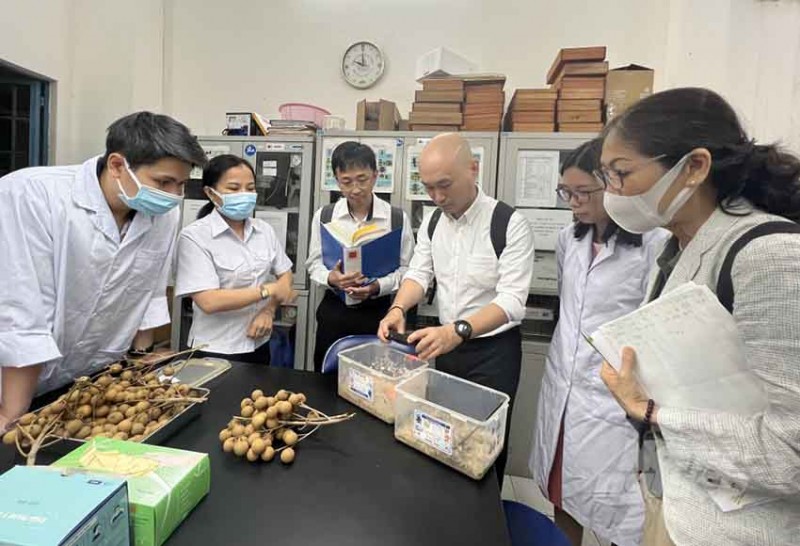Agricultures, Foods
Export promotion of key products in the Japanese market
Vietnamese bananas and longan are popular in Japan, and the Vietnamese Trade Office in the host country plans to carry out export promotion activities for this item.
Mr. Ta Duc Minh, Trade Counselor, Vietnam Trade Office in Japan said: By the end of 2021, Japan will allow the import of fresh Vietnamese longan, this has opened the door to export the country’s strong agricultural products. Vietnam.
Seizing this opportunity, in early 2023, Hoang Phat Co., Ltd. in Long An officially exported the first batch of longan to Japan. Thus, after dragon fruit, mango and lychee, fresh longan has been present in this fastidious market.
Lot of 1 ton longan was transported by air to the shelves at Japanese supermarkets after 4 days. After this batch of longan, each month, Hoang Phat Co., Ltd in Long An is expected to supply about 70-100 tons of fresh longan by sea and by air to Japan.
In order to sustainably export this fruit, in terms of production, the domestic authorities are having solutions to support the granting of planting area codes, packing area codes and regulations on food safety to store fruits and vegetables. Longan continues to increase production in the Japanese market.
“In terms of market promotion, in the coming time, the deal will focus on promoting fresh longan in Japan in various forms,” said Mr. Ta Duc Minh.

Counselor Ta Duc Minh also said: Through discussions with a number of Japanese import and distribution systems, Vietnamese bananas are also highly appreciated. In the Japanese market, Philippine bananas account for 60%, Vietnamese bananas only account for 0.6% market share. Currently, many consumption systems in Japan want to import bananas from Vietnam to replace Philippine bananas because Japanese consumers think that Vietnamese bananas are delicious and increase the purchase of this product. Therefore, this is also the item that the deal focuses on implementing trade promotion activities and product promotion in the near future.
Japan is a key export market of Vietnam, according to statistics, in 2022, Vietnam exported 2.24 billion USD of agricultural and aquatic products to Japan, up 24.5% over the previous year. In which, seafood gained 1.7 billion USD, up 28.8%, coffee reached 277.6 million USD, up 22.6%, vegetables gained 165 million USD, up 7.8%, cashew nuts and pepper also gained impressive growth figures.
Although Vietnamese agricultural products are popular, the representative of the Vietnam Trade Office in Japan also recommended: This is the second most difficult market in the world, so exporting to this market, businesses need to prepare carefully dual.
In particular, businesses need to pay attention to the seasonal consumption characteristics of the people of the host country. Japan has 4 distinct seasons, the dishes and drinks are also required to be suitable for seasonal conditions. Product traceability is also a factor that Japanese consumers focus on.
In addition, in order for trade promotion and market expansion activities to be highly effective, the Vietnam Trade Office also proposed that the Government and ministries support businesses to build cold supply chains such as systems. warehouse, logistics to preserve and transport agricultural products for export. Support enterprises to improve competitiveness, promote products, strictly control quality and food safety standards, traceability. Support enterprises in organizing trade promotion delegations to foreign countries to attend international fairs and exhibitions according to specialties.
On the business side, the Vietnam Trade Office in Japan wishes to: Ensure product quality, stability in selling prices and supply output. Cooperating with Japanese partners to improve designs and models to suit Japanese tastes, focusing on propaganda and promotion of products and brands, building websites, making catalogs in both English and Japanese.
Vietnamese exporters when doing business with Japanese partners should not only stop buying outright – selling segments, but also should continue to monitor and control how their products are received by the market. How do customers respond, in order to avoid unnecessary risks (for example, Vietnamese food products near their expiry date but are still sold by importers in the Japanese market… make an impression? good to consumers…), thereby ensuring the brand reputation of its products.
With the number of 500,000 Vietnamese people living and working in Japan, this is a large consumption channel as well as a channel to promote and spread the effective culinary culture of Vietnam in Japan.
Source: https://congthuong.vn/xuc-tien-xuat-khau-mat-hang-trong-tam-tai-thi-truong-nhat-ban-246650.html
